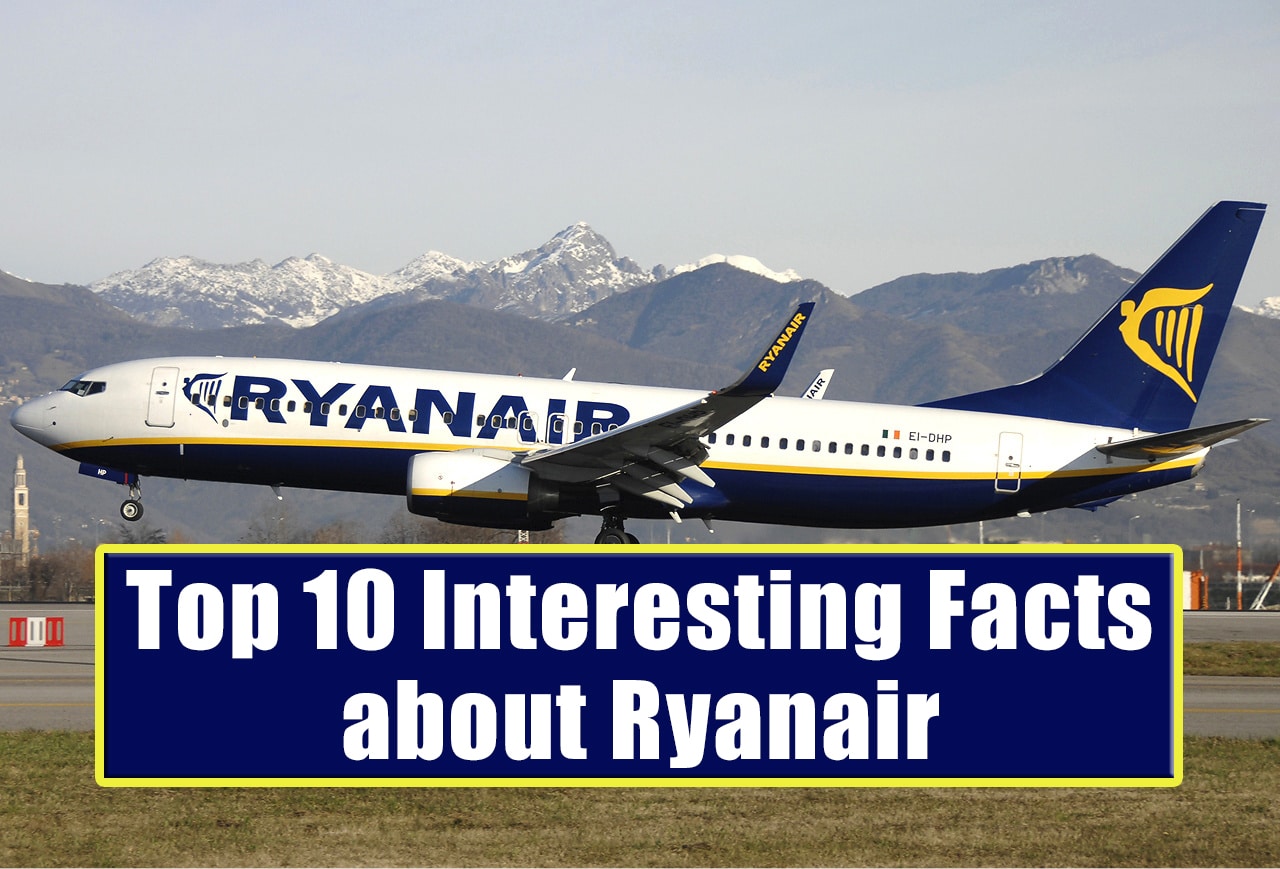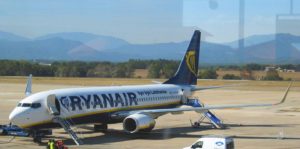Aerospace
Top 10 Interesting Facts about Ryanair

Top 10 Interesting Facts about Ryanair: Ryanair is one of Europe’s largest and successful low-cost carrier airline groups. Ryanair is the parent company of Ryanair UK, Buzz, Malta Air & Lauda as sister airlines.
1. Ryanair started with a share capital of just £1
Ryanair established in the year 1984 by the Ryan family as “Danren Enterprises” with a share capital of just £1 and a staff of 25. It was shortly thereafter renamed “Ryanair” (after Tony Ryan). It started operations in 1985 flying a 15-seat Embraer Bandeirante turboprop aircraft between Waterford and Gatwick Airport.
2. Ryanair starts the first fare war in Europe.
In 1986 Ryanair obtains permission from regulatory authorities to lower the fare price between the Dublin-London route. The launch fare price was £99, which was half the price set by British Airways and Aer Lingus’, later both BA and Aer Lingus slashed their high prices in response to Ryanair’s.
Over the next few years, Ryanair started new routes to other places of Europe such as Stockholm, Brussels, and Paris with 80% low airfares compared to other airlines.
3. No frill, No business class, and single model aircraft.
Ryanair started with the “No frill, No business class, and single model aircraft” principle. New Ryanair aircraft have been delivered with non-reclining seats, no seat-back pockets, safety cards stuck on the back of the seats, and life jackets stowed overhead rather than under the seat. This allows airlines to save on aircraft costs and enables faster cleaning and security checks during the short turnaround times. Ryanair is committed to providing low airfares, this means you have little legroom, have to pay for extra luggage, food, or seat reservations.
4. Ryanair operates the largest no, of Boeing 737 fleet in the world
Ryanair group carried 149m annual customers on more than 2,500 flights per day from 79 bases across Europe and North Africa, the Group connects over 242 airports, operates over 1,800 routes in 40 countries on a fleet of 430 Boeing 737-800 and 29 Airbus A320 aircraft, 270 of them belongs to Ryanair alone, with a further 210 Boeing 737 on order. Which will enable the Group to lower fares and grow traffic to 200m p.a. over the next 4 or 5 years.
5. Europe’s Eco-friendly Airline
Ryanair has a team of over 16,000 highly skilled aviation professionals delivering Europe’s No.1 on-time performance. The average age of the Ryanair fleet is approximately 8 years and is set to get younger with the latest aircraft order. Ryanair is Europe’s greenest cleanest airline group.
6. It is the world’s fourth-largest airline
As indicated by figures from worldwide carrier affiliation IATA, Ryanair conveyed 136.7 million travelers in 2019, behind just Southwest, Delta & American Airlines. It climbed a spot from its fifth spot in 2016, jumping China Southern, which lost its place in the top five to United.
7. A Ryanair aircraft takes off every 45 seconds
Over a normal day, the carrier’s fleet travels somewhere in the range of 382,605 km, as per the airline, visiting 40 nations on 350 aircraft. Research a year ago discovered that a Ryanair airplane flew 46 flights in seven days, to 19 goals, timing up 45,586 km.
Read more :
8. Ryanair launched its own website to cut down travel agents’ fees.
Two 17-year-old understudies’ students were appointed by Ryanair in 2000 to develop the airway’s first site. The airways were obviously cited £3.5million for the design and developments of its online nearness, so they rather moved toward two young people, John Beckett and Tom Lenihan, who carried out the responsibility for around £20,000 to develop Ryanair first site.
9. Ryanair has never had an accident
In 35 years of flying, the closest the carrier has come to a serious accident was On 10 November 2008, Ryanair Flight 4102, from Frankfurt–Hahn Airport, suffered undercarriage damage in an emergency landing at Rome–Ciampino Airport, after experiencing bird strikes, which damaged both engines on approach. Two crew members and eight passengers were taken to hospital with minor injuries.
10. Free Publicity
Ryanair is also known for their provocative advertising, such as deliberately courting controversy to generate free publicity for the airline, have led to a number of complaints to the Advertising Standard Authority (ASA) and occasionally court action being taken against the airlines. Ryanair often uses advertising to make direct comparisons and attack its competitors. One of its advertisements used a picture of the Manneken Pis, a famous Belgian statue of a urinating child, with the words: “Pissed off with Sabena’s high fares? Low fares have arrived in Belgium.” Sabena sued and the court ruled that the advertisements were misleading and offensive. Court-ordered Ryanair to discontinue the advertisements immediately or face fines. Another provocative ad campaign headlined “Expensive BAstards!” compared Ryanair with British Airways price comparisons, but this time court sided with Ryanair.

A Ryanair Boeing 737-800 displaying “bye bye Latehansa” livery referring to German competitor Lufthansa in 2008.
A Ryanair Boeing 737-800 displaying “bye bye Latehansa” livery referring to German competitor Lufthansa in 2008.
In addition, Ryanair has been calling for better customer service since last year, as they regularly performed poorly in customer satisfaction surveys. For many, this may be just one more reason to book Ryanair.

Aerospace
Boeing Transfers Rocket Stage to NASA, Paving Way for Human Moon Mission

Boeing has achieved a significant milestone by providing NASA with the second core stage of the Space Launch System (SLS) rocket.
This crucial component, crafted at NASA’s Michoud Assembly Facility (MAF), is set to propel the Artemis II crew into lunar orbit, marking humanity’s return to deep space after a 50-year hiatus.
The monumental Boeing-built rocket stage, the largest element of the Artemis II mission, will embark on a journey aboard the Pegasus barge, traveling 900 miles to NASA’s Kennedy Space Center.
Comparison of two legendary aircraft B777x vs B747 aircraft:Click here
Upon arrival, it will be meticulously integrated with other essential Artemis II components, including the upper stage, solid rocket boosters, and NASA’s Orion spacecraft within the iconic Vehicle Assembly Building. This intricate integration process is a vital step toward the eagerly anticipated Artemis II launch, slated for 2025.
“Boeing-built products helped land humankind on the moon in 1969, and we’re proud to continue that legacy through the Artemis generation,” remarked Dave Dutcher, vice president and program manager for Boeing’s SLS program. “Together, with NASA and our industry partners and suppliers, we are building the world’s most capable rocket and paving the way to deep space through America’s rocket factory in New Orleans.”
NASA, Lockheed Martin Reveal X-59 Quiet Supersonic Aircraft:Click here
The delivery of Core Stage 2 marks a significant achievement in the evolution of the SLS rocket. Towering over 200 feet and powered by four RS-25 engines, this core stage, coupled with two solid-fueled booster rockets, will generate a staggering 8.8 million pounds of thrust. This immense power is crucial to launching Artemis II and future missions into the vast expanse of space.
The SLS rocket stands unparalleled in its capability to transport both crew and substantial cargo to the moon and beyond in a single launch. Its extraordinary capacity will facilitate the delivery of human-rated spacecraft, habitats, and scientific missions to destinations including the moon and Mars, ushering in a new era of space exploration.
-

 Travel1 week ago
Travel1 week agoAir India to Expand US Operations with Three New Routes After a Decade
-

 Travel2 weeks ago
Travel2 weeks agoWhy We Should Avoid These Stamps in a Passport
-

 Airlines1 month ago
Airlines1 month agoInvestigations Reveal Fake Chinese Titanium in Boeing and Airbus Jets
-

 Tech4 weeks ago
Tech4 weeks agoChina’s CATL Plans 1,800-Mile Electric Plane Launch by 2027
-

 Airport3 days ago
Airport3 days agoTop 10 Largest Airports in the World by Size
-

 Aerospace4 weeks ago
Aerospace4 weeks agoChina’s Fighter Jets Turn Wings into Autonomous Drones
-

 Airlines4 days ago
Airlines4 days agoAir India Rolls Out A350s for Delhi-New York JFK and Newark Routes
-

 Defence3 weeks ago
Defence3 weeks agoBoeing Enhances Chinook with New Engines and Block II Upgrades at $96 Million







